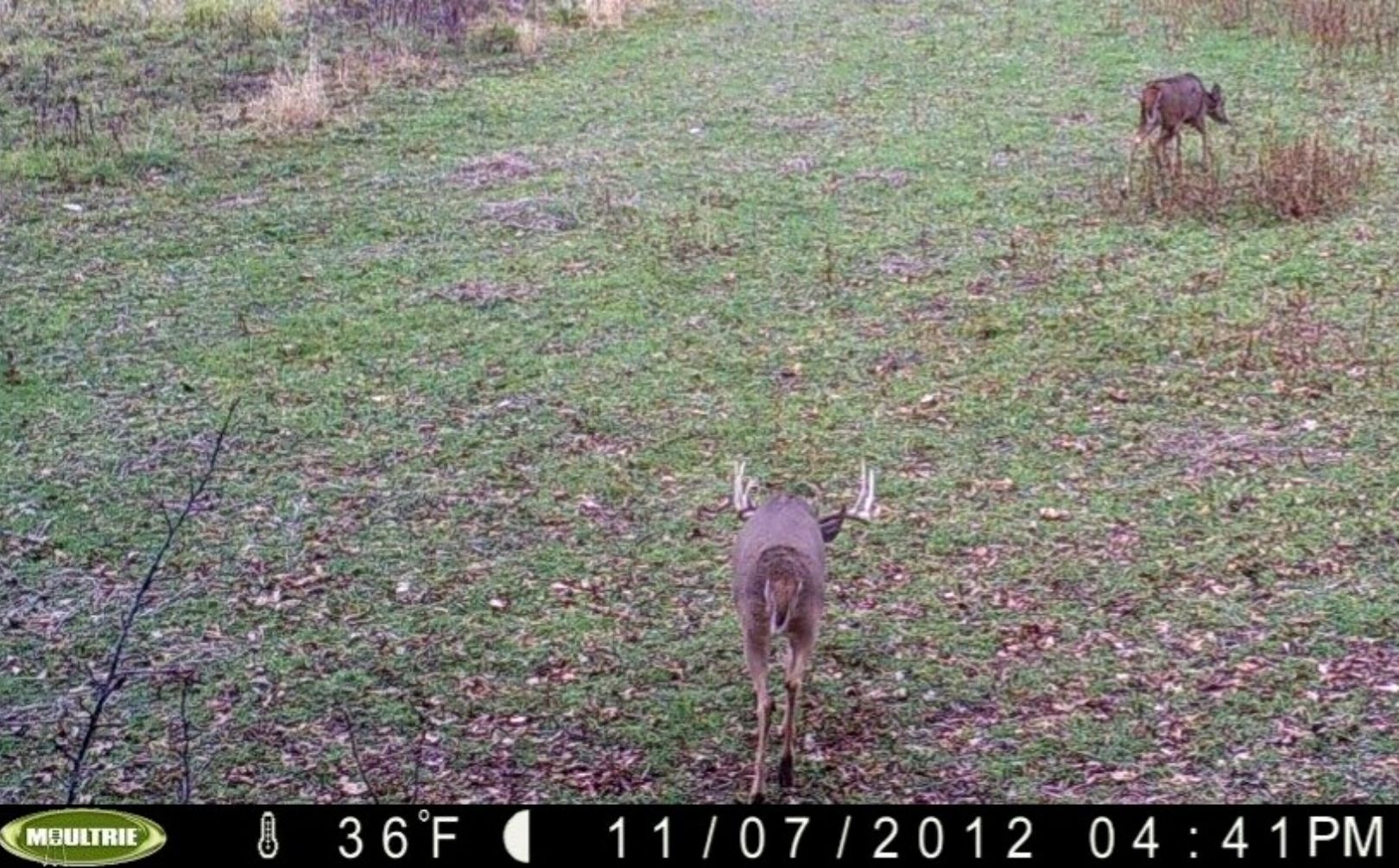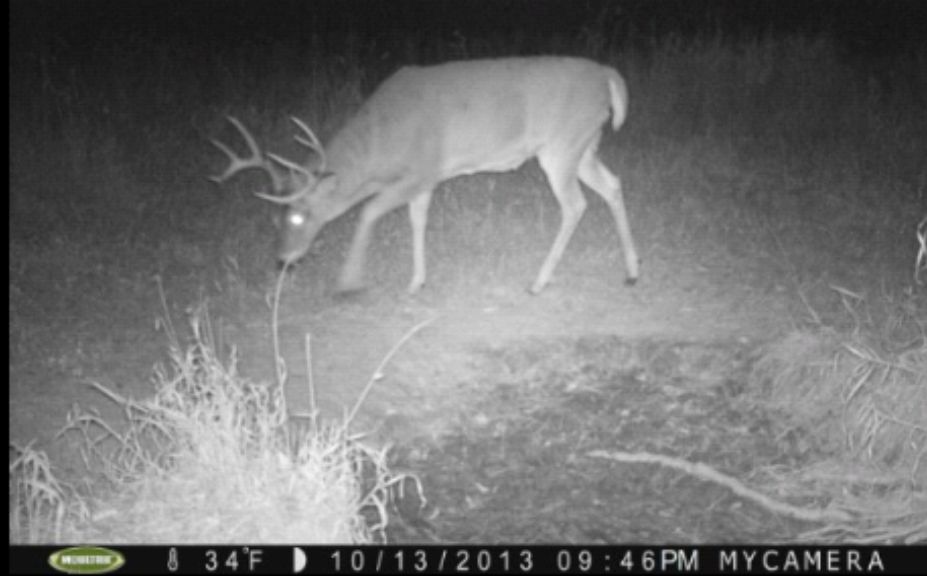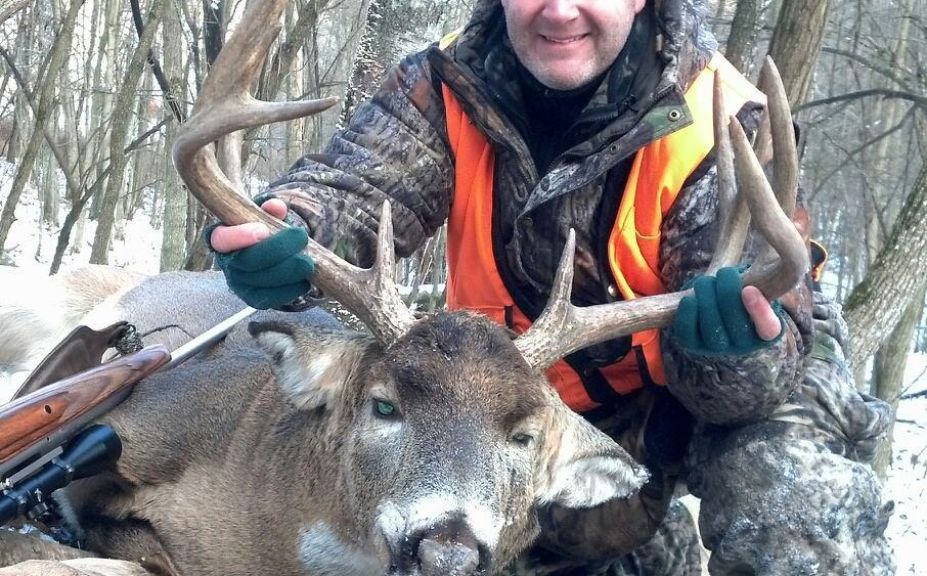
*For my latest article concerning deer hunting plots, make sure to check out "Hunting Food Plots: Where To Plant".
Throughout the years I've enjoyed getting to know a few mature bucks, as well as being able to be involved in hunting them. A glaring statistic I've shared before and I think is worth repeating is that less than 5% of those dozens of mature bucks were killed on a food plot. At the same time, food sources whether they were man-made deer hunting plots or not, contributed to the harvest of at least 40% of those mature bucks.
For example, this 2012 deer cam pic is of my 2013 WI rifle buck who was an occasional visitor of one of my remote, "hunting plots". Although I am sure the small plot he visited played a vital role in his eventual demise, he was harvested over 300 yards away on the edge of a small, wooded, daytime sanctuary area. When talking about deer hunting plots for small parcels, is the term "Hunting Plot" even accurate?
Lets face it; a hidden honey-hole of lush green forages in contrast to a backdrop of habitat blanketed in autumn's beauty is pretty easy on the eyes! Also, a hidden food source and how it relates to your other parcel components of food and cover can be a powerful tool within your overall hunting and management objective. What I would like you to do is to take a step back and think about the concept of Lines of Movement. What is a line of movement? A line of movement is a daily deer travel pattern of that you can recognize, create, use, and possibly enhance or manipulate to predict where deer will travel on the land you hunt. A hunting plot should simply be a piece of that line of movement. A line of deer movement should include not only food, but also cover and secure travel as well. When you take a closer look at a line of movement, you will find that you have an opportunity to potentially kill a deer anywhere along that line whether it is within the food source, the cover, or the secure travel that you are either recognizing or attempting to manipulate. Where have the majority of your buck harvests taken place? Personally, the vast majority of my buck harvests have taken place within the "cover" portion of a line of daily deer movement, as well as within the secure travel routes. Do you have any hunting plots on the land that you hunt? I do...but I often wonder if the label of "hunting" is a very good focus.

*For me personally if I can't find and recognize a strong line of deer movement to hunt, I move on. For more info about recognizing lines of deer movement, try reading "Lines of Deer Movement".
In my experience the term hunting plot is misleading and pulls the user away from a more accurate understanding of just how powerful of a tool a small food source can actually be, because when you think about it, is it even a good idea to hunt those small food sources in the first place? I'm going to share with you my thoughts on how you should use small food sources, why you should use small food sources, and when you should use small food sources to attain your management and hunting objectives. I'm also going to share with you that while you probably shouldn't take a Hunting Plot out of your food plot program, you may often be better off to take the "hunting" out of the plot.
Daily Deer Patterns
Does your small plot fit within a pattern of movement on the property, or is it it's own little center of attention? When a property component such as a food source or bedding area does not fit within a pattern of use on your parcel, it leads to random movements within your parcel. Random deer movements are unpredictable and very difficult to pattern. A movement is random when you have a difficult time answering, "Where do the deer go now?" If they are on the way to another habitat component on your land such as a bedding area, than they certainly are not random. However, when a deer gets to a dead-end component as a random hunting plot, the deer basically have just a few options, including:
1. The deer can leave your parcel to find the next component they are afteron someone else's land.
2. They can possibly reverse their direction and travel back towards a piece of habitat on your own land they may happen to have in mind.
3. They can simply stay....and stay-and stay-and stay, making it impossible to get into or out of our stand without spooking them.
I have found if you spook a mature buck 1 time on a small food plot, your chances of reaching your entire small parcel's potential of hunting and herd management objectives are greatly reduced.
On a small parcel you simply can't afford to create any random lines of movements. So, when you choose to install a small food source, choose only to do so when it fits within the daily pattern of movement you are attempting to promote within your parcel. If your food plot is a potential dead-end, you may want to resist the temptation to create it, no matter how pretty the results may be.
Keep Them Interested
In my experience, deer seem to like variety. They like to eat, they like to sleep, and believe it or not I've even observed young fawns that appeared to be "playing" with the snowshoe hares that would visit the food plots to feed along side the deer. It does seem that deer sometimes even like to play...have you ever witnessed their playful nature? When you don't offer them a good spot to eat or sleep, or possibly even a spot tofool around, they can be off to your neighbor's land.
As a landowner you need to figure out a way to keep the deer interested in the variety of habitat that you offer on your parcel. If you are hunting public land, I urge you to locate and scout remote areas that feature the highest level of habitat diversity that you can find. That may mean that you need to locate as much food as you can, as in the case of many northern wilderness settings. On the otherhand, you may decide that the land you hunt within an open agricultural region could benefit from a boost in quality cover. It may also mean that you need a little bit of both cover AND food source improvement to keep the deer interested, but one thing is for sure, if they deer don't have diversity, they will leave. A small food source can be a great addition to your land if its going to be an attractive piece of the daily patterns you are trying to promote, but that's not all.

*This 2013 buck was a frequent visitor of the deer hunting plot that eventually helped to lead to his demise; even though he was harvested a great distance from the plot! Keeping a deer hunting plot free from hunting pressure is absolutely critical to your success, for more tips on increasing the daytime deer movements on your land, try reading "Low Pressure Food Plots".
A small food source can help you to predict where a deer is going to be, which means it will help you in your hunting efforts as well. And that doesn't mean that you have to hunt it! Great things can happen when you create a food source or other habitat hotspot such as cover, water or even a travel corridor, and then you leave that improvement to heat up as the season progresses. When deer continue to travel daily within secure deer movements, they can become very easy to pattern. As deer continue to use a food plot safely within their daily patterns, I believe they begin to lower their gaurd a bit, which in turn offers you an oustanding opportunity. But even when that opportunity presents itself, there is often only a small window of utilization when it comes to actually hunting, a hunting plot.
A Quiet Ambush
When the table is set for daily deer usage and comfort, when the wind is right, when the time of day and season is perfectgo in for the kill! Ive greatly enjoyed watching deer on small harvest plots that lead to larger food sources or bedding areas. The deer travel through, they munch a bit, and then they are off to their preferred destination. The key is munch a bit, meaning you dont want them to spend a lot of time camped out in from of your stand keeping you from either getting in non-invasively, or out! I find in the early season deer are in much less of a hurry, preferring to move slowly, be lazy, and to build energy reserves.
While deer may be moving more slowly in the early season, they often quicken the pace towards the pre-rut and rut. Deer experience a heightened level of stress during the various periods of the rut and often appear nervous and edgy. A buck could be coming through at anytime to disrupt their otherwise daily routines and at the same time the amount of food source on small plots is typically shrinking. Now, is the time I like to hunt small food sources, even all day! Cruising bucks during daytime hours love keying on small food sources, and if you combine your small food source without a downwind heavy travel corridor connected to outside adequate secure travel routes a daytime ambush is not out of the question. During the rut adding a small water source in an area that does not have adequate water supplies can be an outstanding draw in itself, let alone the small food plot it is adjacent to.
When thinking of a time to use your plot, think of a time when you will not spook ANY deer because over-hunting your hunting plots can be a bad habitat to get into.
Conclusion
"Travel Plots", "Pass-through Plots", "Snack Plots"-really, nothing seems to have a better ring to it than "Hunting Plot". I'm not sure that I'm really sold on that catchy title either, but whatever you call it, it can be a great feature to install on your parcel, depending on of course: The location. At the same time let the user beware, as in any food source it can really help you, or hurt you depending on why you use it, how you use it, and when you use it. I think that most of you could agree that a hunting plot can be an extremely rewarding and critical component of your management efforts. However, to experience your ultimate level of success, you may find that you need to practice removing a bit more "hunt" out of your hunting plots!